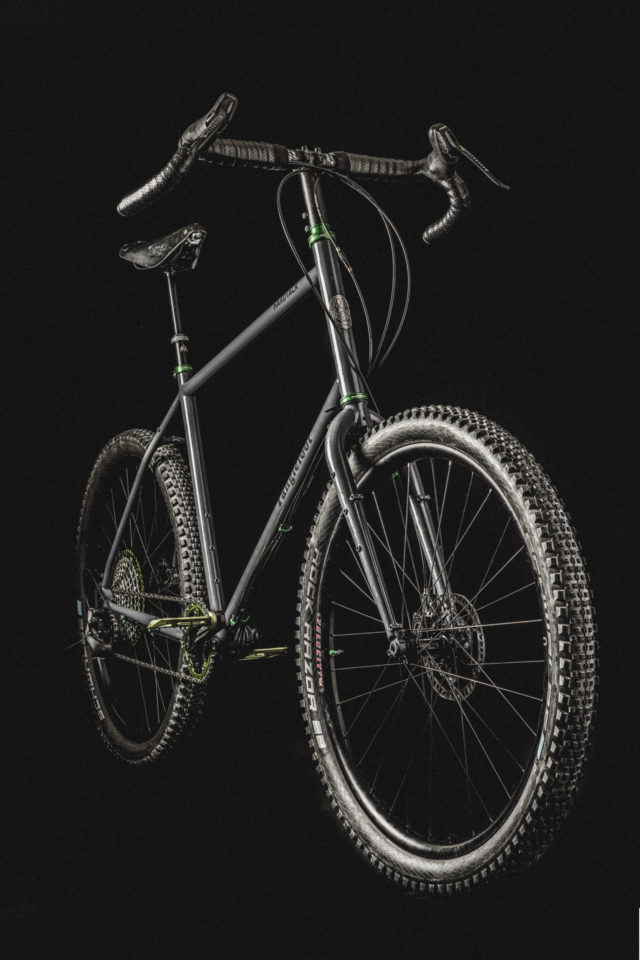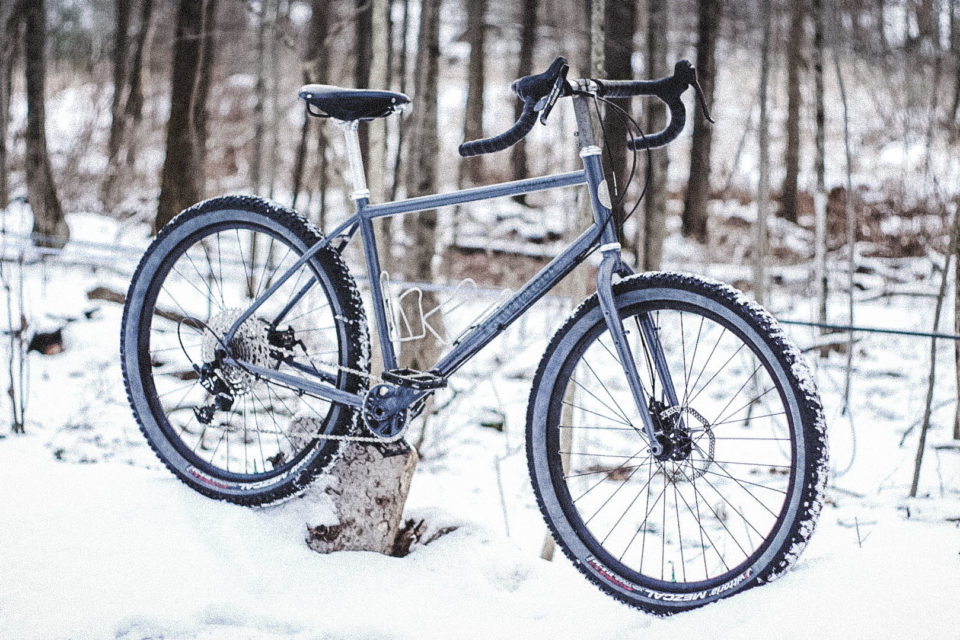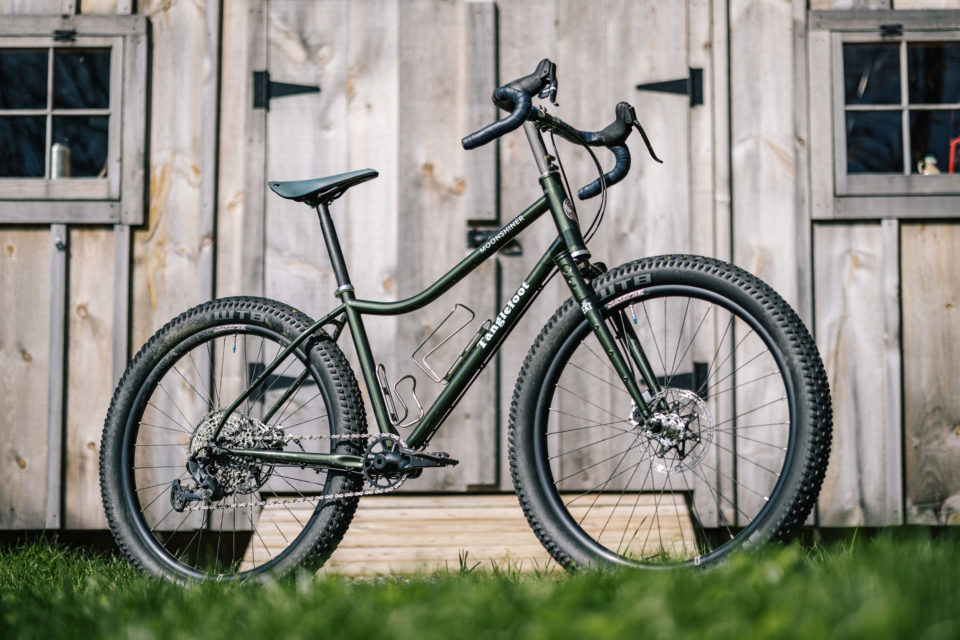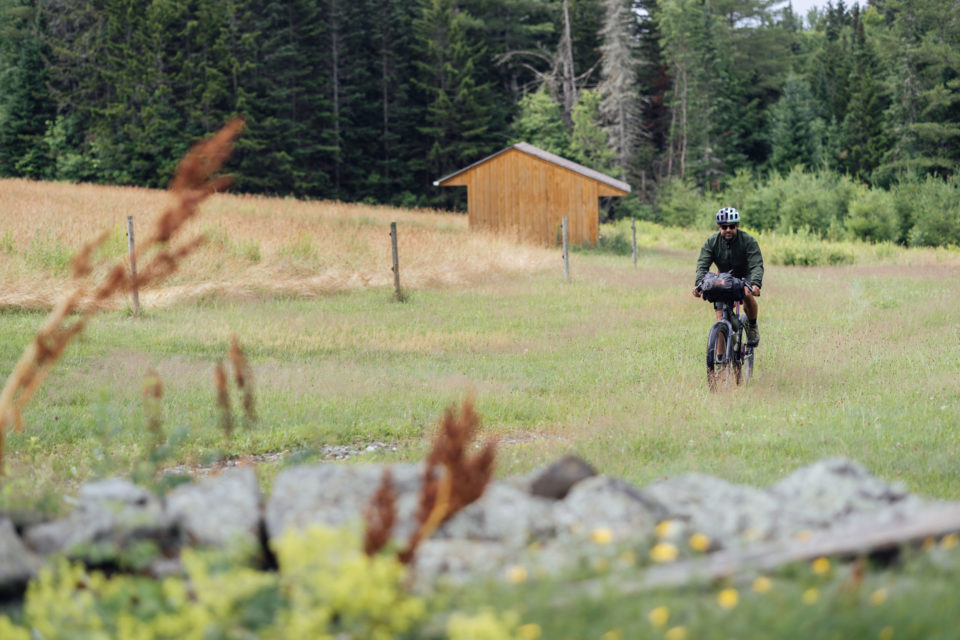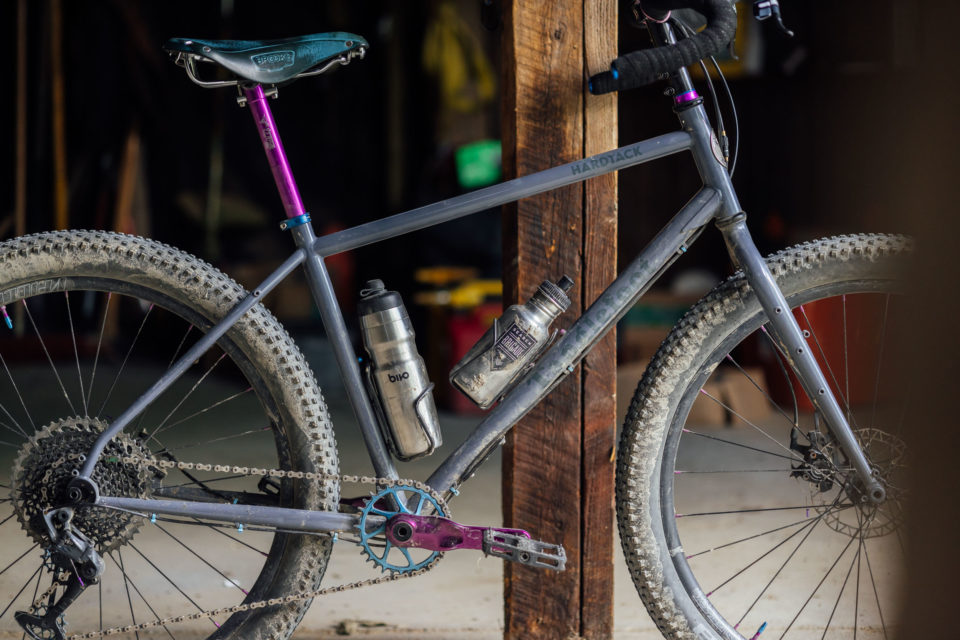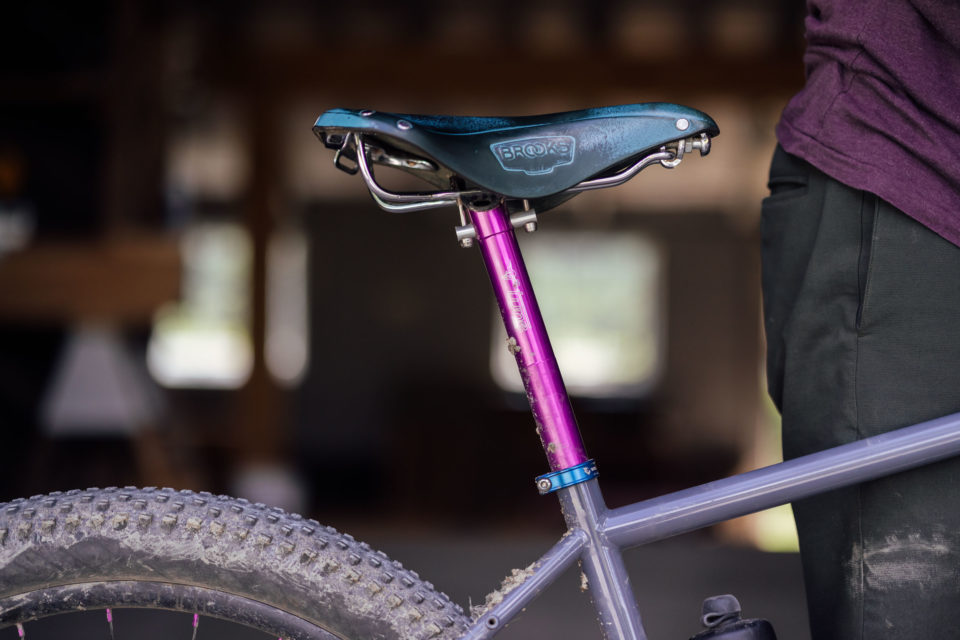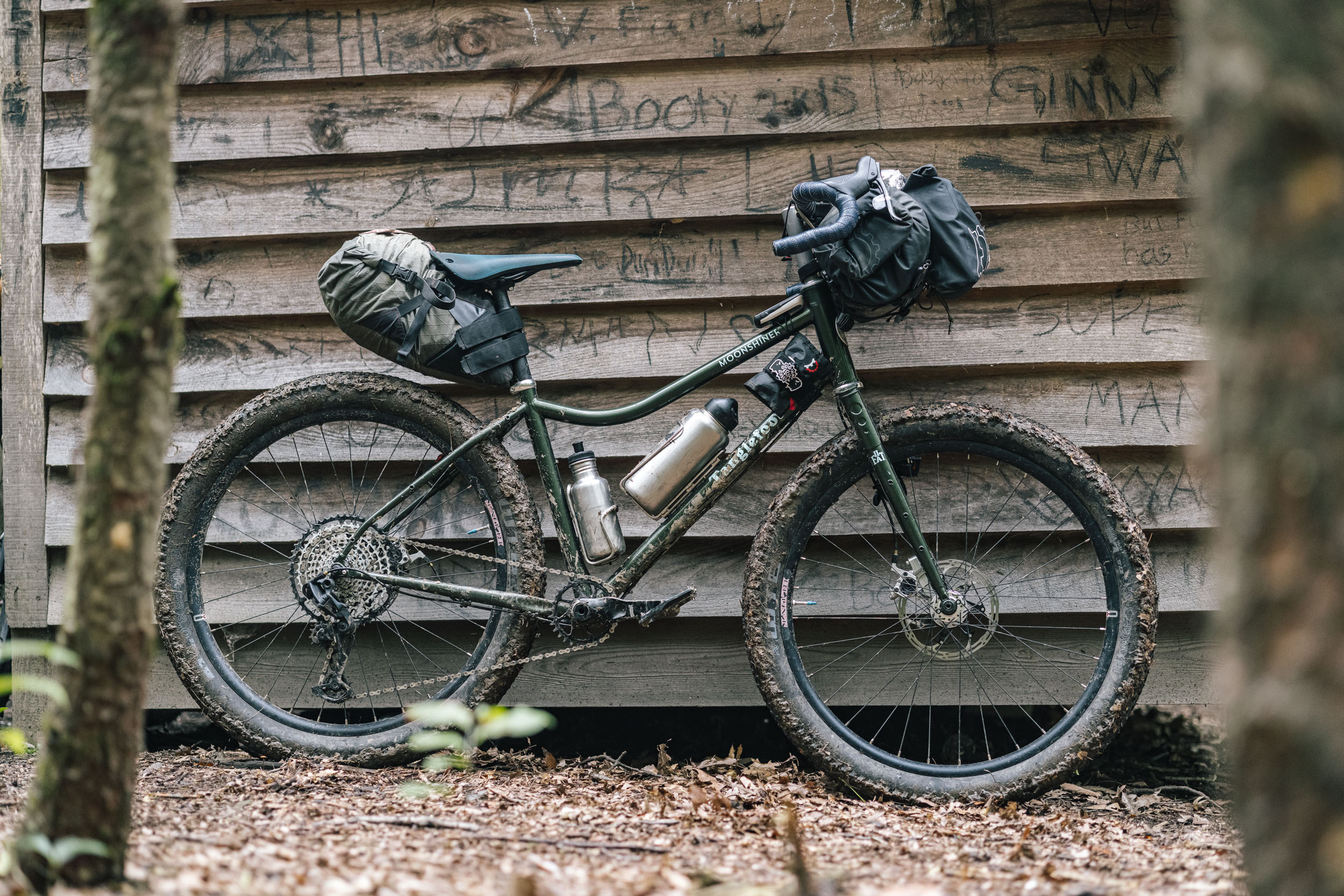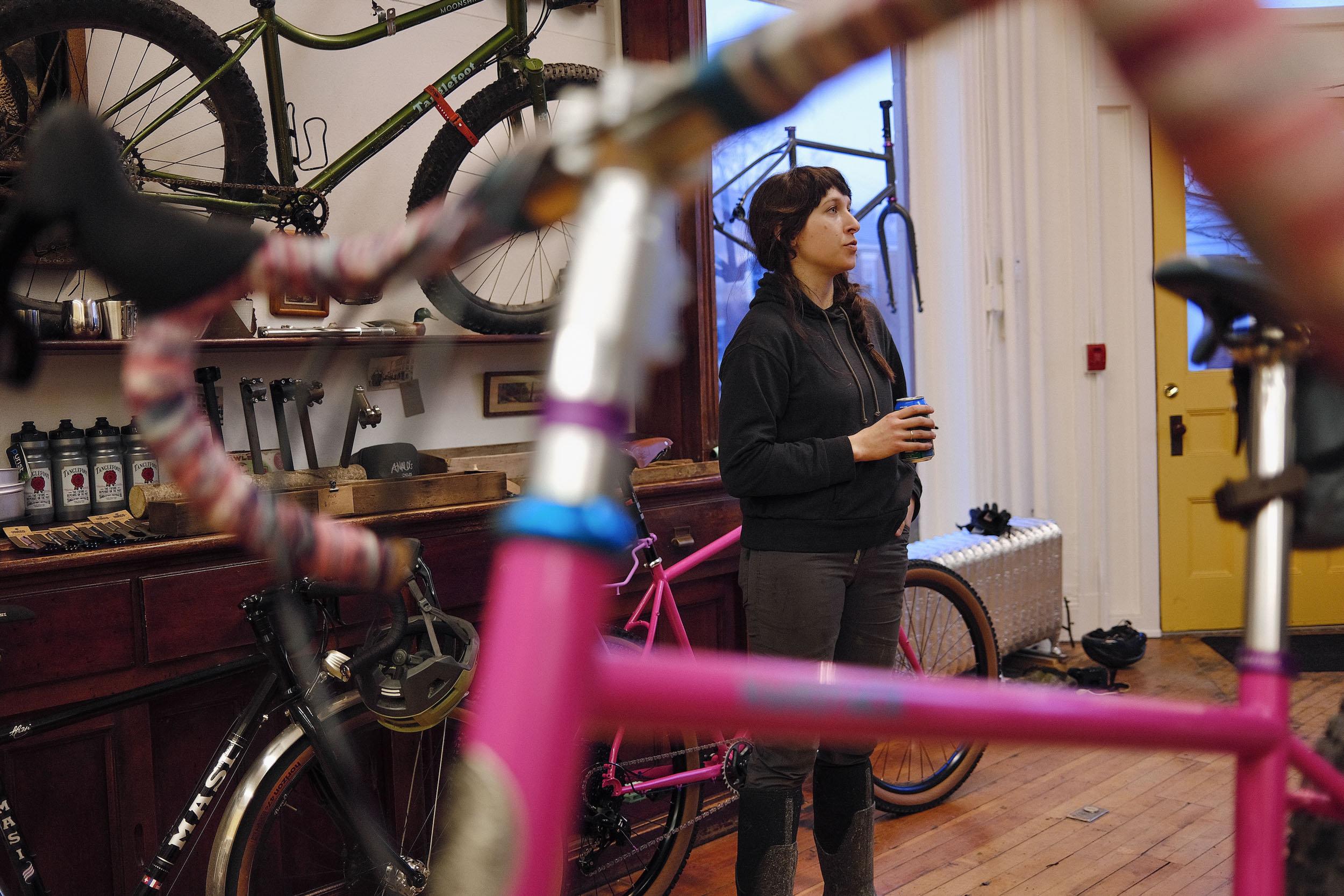Tanglefoot Hardtack Review
At the end of last year, Joe reviewed the Tanglefoot Moonshiner, a sure-footed ATB conceived for woodsy New England terrain but suitable for all manner of bikepacking in rugged environs. Readers will remember that he loved the Moonshiner for its handling and flat-out prowess on his favorite kinds of exploratory rides. The Hardtack is a lighter-duty sibling to the ‘Shiner, and it shares its dominant philosophy. Read on to find out how Joe thinks the two compare…
PUBLISHED Aug 23, 2022
Photos by Logan Watts
I recently spent a few days pedaling Tanglefoot’s Hardtack unloaded on dirt roads and singletrack as well as on a multi-night trip. Tanglefoot is the in-house brand of Analog Cycles in Poultney, Vermont, co-owned by Candice Passehl and James Johnson. I was excited once again to experience James’s distinctive design ideas for an all terrain bike. My time on the Hardtack was short, but the experience was positive and familiar from riding their Moonshiner model last year. The bikes have a notable family resemblance, and much of what I want to say about the Hardtack is usefully presented in comparison to the Moonshiner. Here, then, is not quite a full review, but something more like an addendum to the earlier piece. (The Moonshiner review very nearly got me fired for being over six thousand words. Something about using up all the server space and, “No, we’re not going to pay you ¢15/word…” So perhaps this one can tolerate being shorter.)
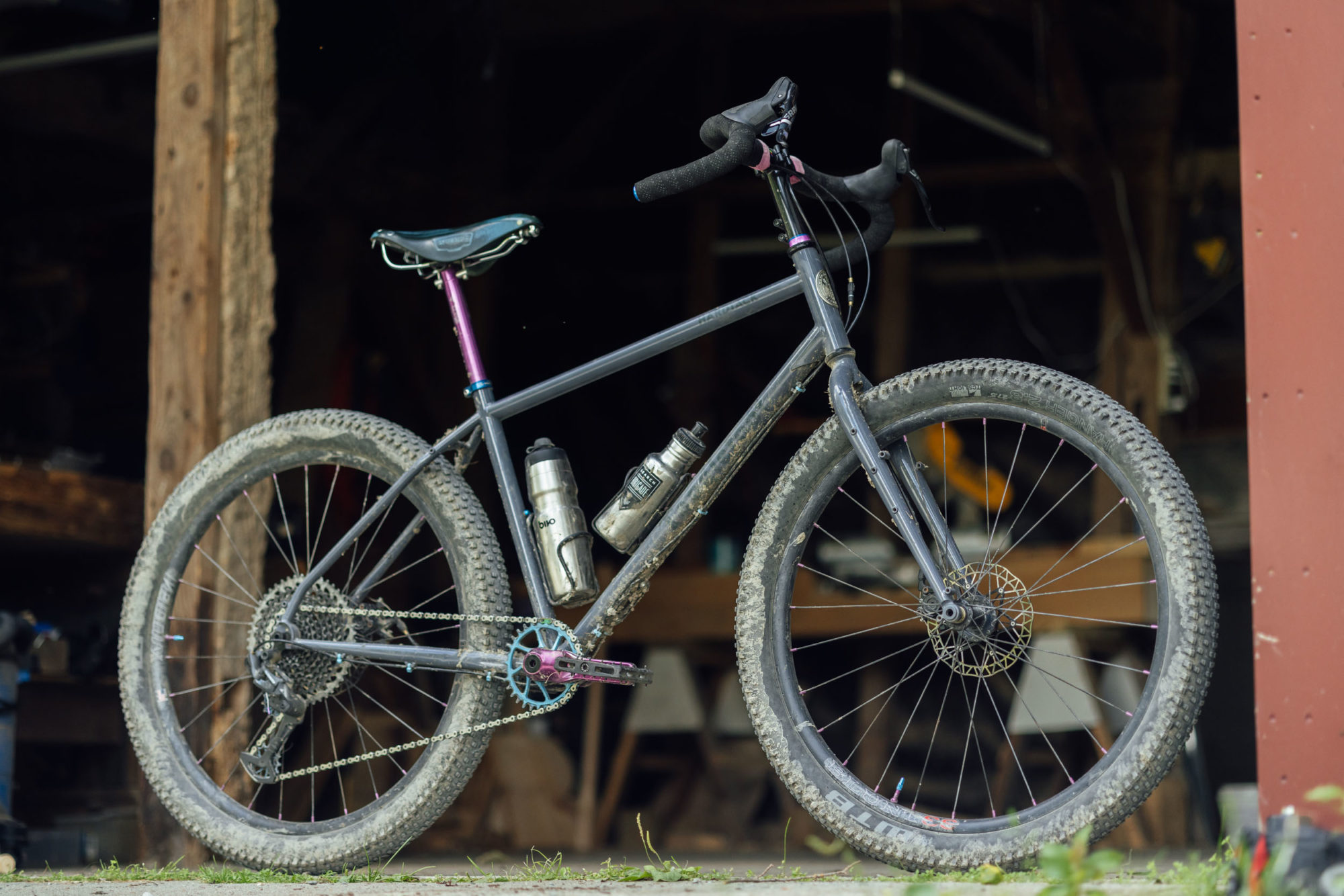
Overall Impressions
The Hardtack feels stable and purposeful when bounding through the USA’s East Coast terrain while remaining nimble enough at low speed to handle tight turns through stacked singletrack. It is steady, maneuverable, and calm in old woods. For me, it was better at slower, picking-my-way-through speeds, rather than at railing bermed corners. I wouldn’t say that the bike is nervous at velocity, it’s just that straight-line downhill prowess is a lower priority than threading roots and ruts.
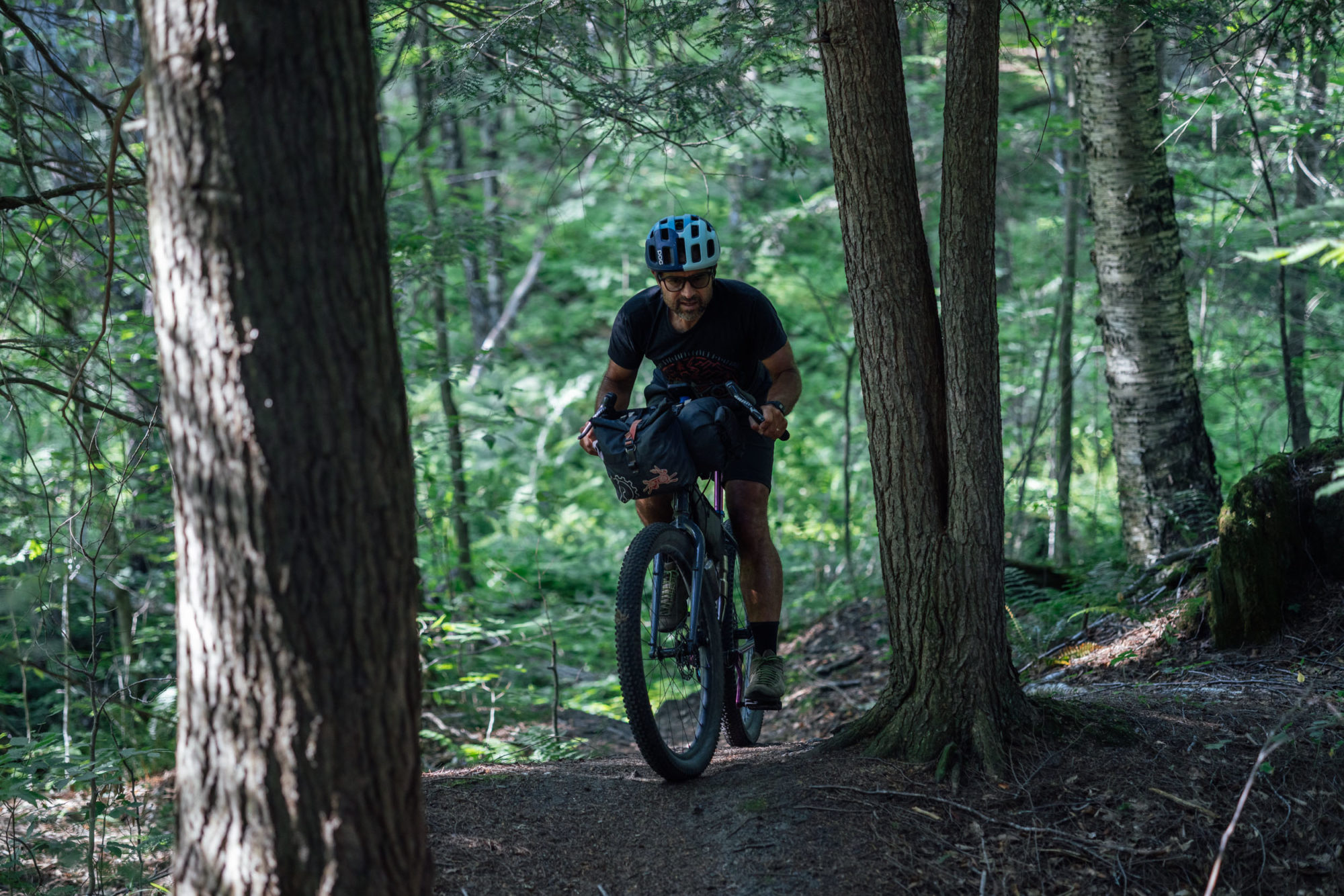
And all of this is conceived in a format that has riding in the drops the primary position. That is the dominant standout feature on the Hardtack, and it’s the thing that one must come to grips with, so to speak, when contemplating this bicycle. The hoods and the tops are usable and intended to be functional, but the most natural and confident control position is in the hooks, reminiscent of some of the earliest proper mountain bikes. That’s the key to making sense of the way-high stack height and the outlandishly short stem, which for most riders will be either 0mm or 30mm. These unusual dimensions operate synergistically with the top tube length, head tube angle, and seat tube angle to yield a good-behaving, no toe overlap ride. In my earlier review of the Tanglefoot Moonshiner, I spent some time trying to debunk the idea that there is some straightforward canon with regard to geometry and stack height and stem length. Tanglefoot bikes represent a specific point of view on fit, handling, and use-case, and their essential dimensions all answer to that point of view.
The thing to emphasize, therefore, is that it is utterly futile to look at the geometry chart of the Hardtack and try to picture what the bike rides like. I’d say that that is almost always a fool’s mission, given how many small interrelated factors go into determining how a bicycle handles. Like any complex system, the chances of faithfully modeling in your imagination the emergent effect of “feel” is vanishingly low. That’s going to be especially true for a bicycle that seems to violate some central premises of mainstream design.
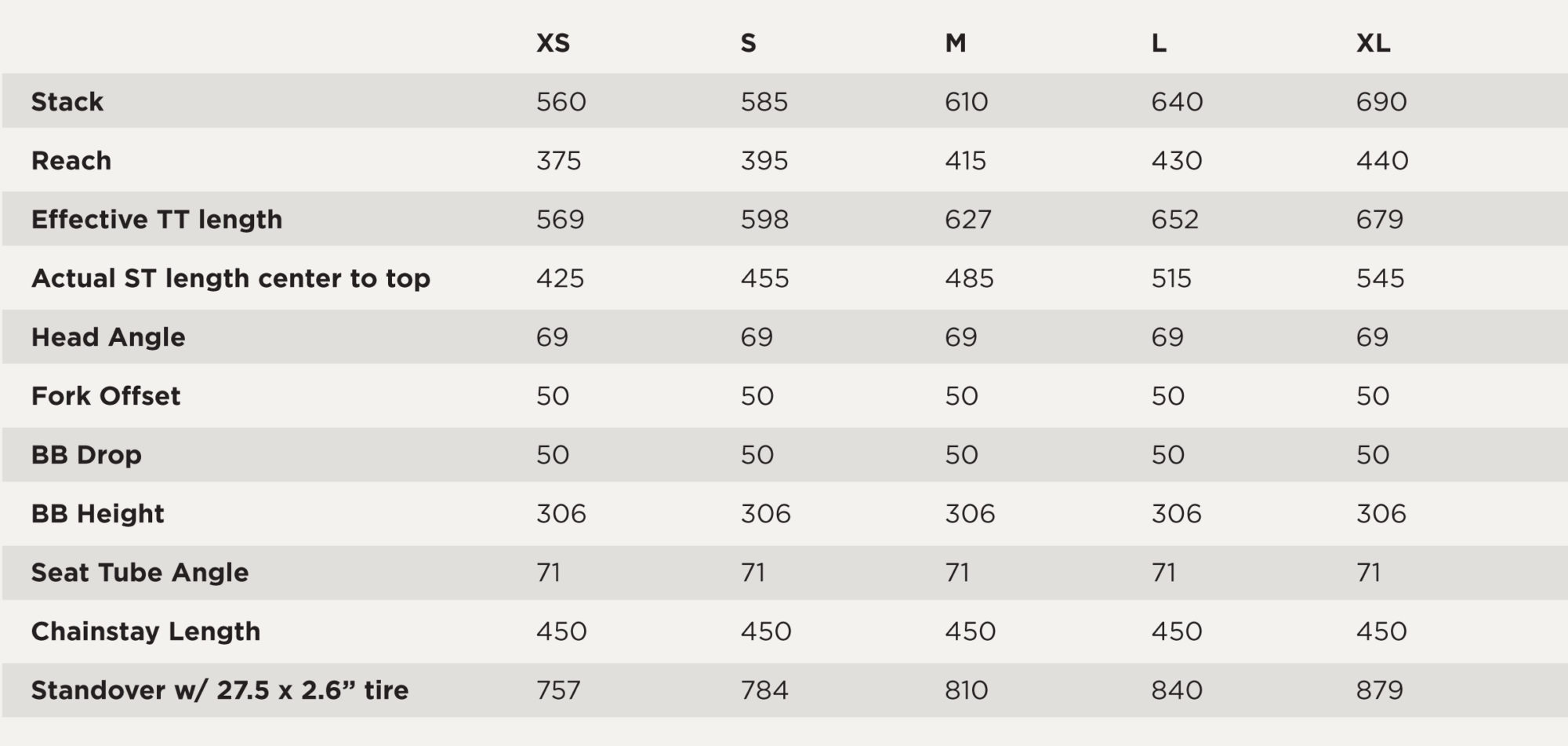
But where does that leave us? I completely understand that it will be colossally unsatisfying to just take my word for it when I say that Tanglefoot bikes ride great, the Hardtack emphatically included. I’ll say it again, though: the Hardtack’s manners in the woods are impeccable—comparable to, say, my old Wicked Fat Chance. It is fun to point into a rocky doubletrack, it encourages a graceful dance over logs and abandoned stone walls, and it manifests precisely the values of ATB riding that I look for, namely a sense of getting outside to keep your head up exploring back roads and remote tracks.
Hardtack vs. Moonshiner
Compared to the Moonshiner, the Hardtack aims to be a lighter-duty ATB and is perhaps better suited to dirt road rides than its burlier sibling. There are the easily quantifiable differences: the Hardtack has standard 100/142mm hub spacing, a more traditional looking main triangle, and a lighter, less stiff fork with less refined casting. These translate into a more affordable frameset. The published max tire clearance of the Moonshiner is 27.5 x 3.0″, while the Hardtack is listed as 27.5 x 2.6″. Sharp eyes will confirm that I was riding WTB Ranger 27.5 x 2.8s with no worries about clearance.
James has ventured that, “If your riding is 60% dirt roads, 20% singletrack, and 20% pavement, you want the Hardtack. If it’s 60% bad dirt roads/chunky singletrack and 40% other stuff, you want the Moonshiner.” I get where James is coming from here, and gainsaying the designer is risky. For sure, the difference between the Hardtack and Moonshiner is, to me, quite noticeable, and any comparative evaluation will be entirely a matter of how the bicycle will be ridden. But I do think James’s claim underestimates the Hardtack a bit. It’s plenty excellent as a mountain bike. Sure, it’s a fully rigid mountain bike with maybe 2.4” tires, but in that reference class, it’s very accomplished. So, even if someone sees themselves riding half the time on good dirt roads and half the time on significantly less improved tracks (with some inevitable pavement connectors thrown in), I think the Hardtack is well in the running.
For me, the real contrast is that the Moonshiner puts me in the mindset of fat and plus bikes, namely rigid bikes that are unstoppable in all terrain and with the equanimity to float through the chunkiest terrain with aplomb. That is the kind of bicycle that I reach for on the most far away, unpredictable rides, or for when I’m going riding in some part of the state forest on a jeep track I’ve never seen before or heard about anyone giving a go. The flip obvious side of that is the Moonshiner feels more ponderous, less willing to accelerate, and more of a chore on roads.
The Hardtack is envisioned more clearly as an everyday mixed-conditions ride. The difference is even more apparent in the other direction, when setting up the Hardtack as a muscular gravel bike. Narrower tires on the Hardtack make complete sense, as the bike is optimized to feel equally adept with lighter wheels. You won’t mistake it for a speed-centric gravel bike, but it’s fast and confident and joyful on gravel roads, even if you wouldn’t necessarily press it into a gravel race.

The Hardtack felt not quite as precise in boulder gardens as the Moonshiner. Not because it’s flexy—it definitely is not, that’s not the MO of Tanglefoot bikes—but rather because it had a discernibly lighter touch. Some of this might be due to the lower pneumatic trail and some might be due to the lighter weight of the fork. There was likely some role played by the spendy light build of the Hardtack I tested. It’s Candice Passehl’s personal fast bike, and it is eager and flickable.
As far as which I would choose between these two very satisfying ATBs, I prefer the Moonshiner. It’s just more my style of slow, indulgent, anything/anywhere plus platforms. The Moonshiner has a magic that draws me in, while the Hardtack falls more in my category of, “Heck yeah, great bike. A lot of people will like this.” I say that, I hasten, from the perspective of having other bikes that I ride on gravel rides. If I was shopping for a one bike for everything dirt-worthy ride, I wouldn’t be so confident in picking the Moonshiner over the Hardtack.
Bikepacking on the Hardtack
I took the Hardtack out on a multi-night trip in New England, and it was terrific with a light summertime load. The high stack creates abundant room for a plump front roll without the slightest chance of making contact with the front wheel. The fairly generous dimensions of the main triangle make it easy to combine a half frame bag with a couple of bottles, and a custom full frame bag would have a lot of room even in the smaller sized frames. It wasn’t the kind of trip where I needed the abundant attachment points, but the Hardtack has them all as well as rack provisions.
I appreciated the way the Hardtack handled with luggage. It slowed things down somewhat, and that put the handling deeper into the frame of what I prefer.

Half way through the trip, the darnedest thing happened. The pad portion of one of the brake pads somehow unglued from the metal backing plate and disappeared, presumably into the brush. That caliper was instantly useless, and I hadn’t brought spares for a short outing. I transferred the good set of pads from the back to the front. It is not the official position of BIKEPACKING.com that you should discard your rear brake to save weight or anything like that, but I am happy to report that not having the rear brake didn’t matter that much. I was cautious about my speed and there were times in the woods where I had to think through how to approach a chute or a hole, but it was basically fine. The Hardtack’s very balanced and kind trail manners certainly didn’t hurt.

Build
When you buy a Tanglefoot, you’ll work with Analog Cycles or your dealer to spec parts that suit your needs and budget. As I mentioned above, the test bike I was on is a scorching premium configuration, as you’d expect in the hands of the company co-owner. Candice estimates that hers falls into about the US $6,000 range, but less rarified builds are coming in starting at about US $3,200.
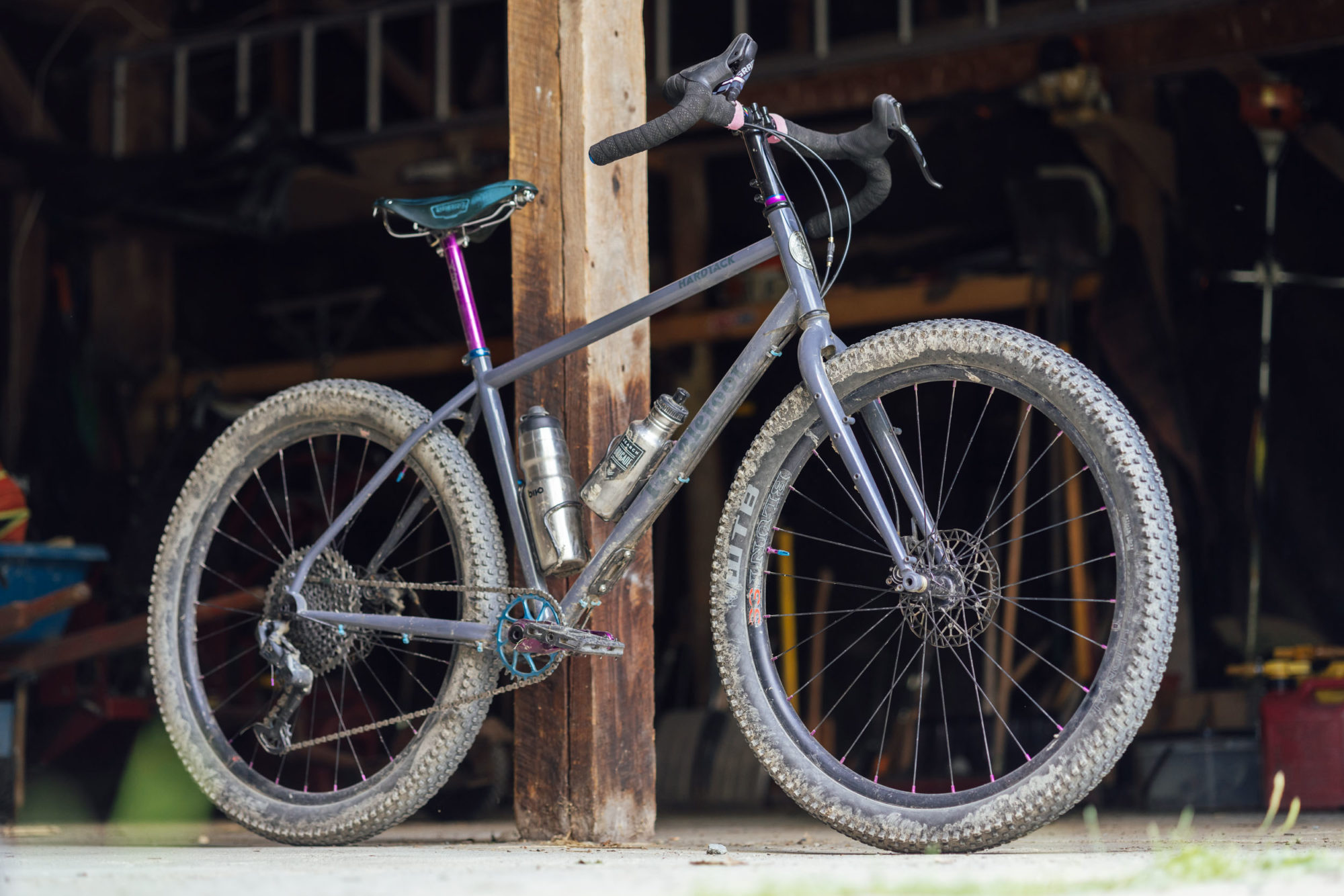
I’ll mention just three things about the parts on the test bike: I was once again very impressed by the Ignite crankset; good things are happening over at Ignite. The wide shifting range on the SRAM derailleur with the Force levers is achieved through the use of a Ratio shifter rebuild kit. It was flawless. And the 0mm stem is made by Discord, another Analog Cycles brand.
At the time of this writing, Tanglefoot has the complete size range of the Hardtack and both colors—slate and maglia rosa, a hot pink—available.
- Model/Size Tested: Small
- Actual Weight: 24.5 lbs/11.1kg (with pedals)
- Place of Manufacture: Taiwan
- Price: US $6,000 (Analog’s estimate)
- Manufacturer’s Details: TanglefootCycles.com
Pros
- Versatile ATB, great on dirt roads and light trail duty alike
- Excellent for bikepacking with lots of room for a front roll or bag
- Confident and nimble East Coast USA handling
Cons
- Geometry, stack, stem length, and drop bar all work together, so it is inadvisable to stray too far with parts changes
- Better at lower speeds in the woods rather than flat out at high speeds
Wrap Up
If Tanglefoot bikes look funky to you, get over that (after all, your bike would look funky and incorrect to the most talented bicycle engineers for most of the history of the bicycle.) The Hardtack is a legitimate contender in the most versatile space of ATBs—namely simple, reliable, great-performing bikes especially suited to dirt roads shading into crumbly doubletrack and singletrack. The Hardtack is part of an interesting movement that includes bikes by the likes of Tumbleweed, Crust, Black Mountain, and Surly—to make supremely capable steel drop-bar bikes with modern touches. These are just the kind of bikes many of us are drawn to for a bucket-list mission like the Eastern Divide Trail.
The Hardtack presents its own take on the idea: Keep the seat tube slack, a 69 degree head tube, lengthen the bike to guarantee no toe overlap, maintain a high bottom bracket, design around a stiff fork, shorten the stem to be able to comfortably use a drop bar, and insist on a neutral, functional fit while in the hooks. The bike works, is excellent for bikepacking, and is a blast to ride.
Related Content
Make sure to dig into these related articles for more info...
Please keep the conversation civil, constructive, and inclusive, or your comment will be removed.

















